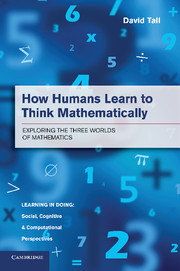Book contents
- Frontmatter
- Dedication
- Contents
- Series Foreword
- Journeys through three worlds of mathematics
- Preface
- Acknowledgements
- Illustration Credits
- I Prelude
- II School Mathematics and Its Consequences
- III Interlude
- 9 The Historical Evolution of Mathematics
- IV University Mathematics and Beyond
- Appendix Where It All Came From
- References
- Index
9 - The Historical Evolution of Mathematics
from III - Interlude
Published online by Cambridge University Press: 05 June 2014
- Frontmatter
- Dedication
- Contents
- Series Foreword
- Journeys through three worlds of mathematics
- Preface
- Acknowledgements
- Illustration Credits
- I Prelude
- II School Mathematics and Its Consequences
- III Interlude
- 9 The Historical Evolution of Mathematics
- IV University Mathematics and Beyond
- Appendix Where It All Came From
- References
- Index
Summary
The mathematics we use today is part of the ongoing evolution of ideas as succeeding generations build on the progress of their predecessors. At this current time in history, we can see the mathematical landscape changing before our eyes as computers allow us to operate mathematically in ways that were unimaginable a generation ago.
In each generation, children are introduced to the concepts currently available in their culture, and as adults they may blend ideas together to create new forms of mathematics to pass on to subsequent generations. The history of mathematics is the story of these successive advances.
This chapter focuses on events that trace the evolution of mathematics over the centuries, to illustrate that historical development also follows a sequence formulated in the three worlds of mathematics from practical embodiment and symbolism, to the development of theoretical mathematics in geometry and algebra, with their blending in the Cartesian plane and the problematic issues of negative and complex numbers in the solution of equations. The development of the calculus offers a new blending of perception of change and the power of symbolism accompanied by the problematic notion of infinitesimal. The advances of the nineteenth century addressed problematic aspects in a range of areas, leading to the formalism of the twentieth century, which continues to develop increasing power while supportive and problematic issues continue as the boundaries of mathematical thinking extend into the future.
- Type
- Chapter
- Information
- How Humans Learn to Think MathematicallyExploring the Three Worlds of Mathematics, pp. 215 - 252Publisher: Cambridge University PressPrint publication year: 2013



